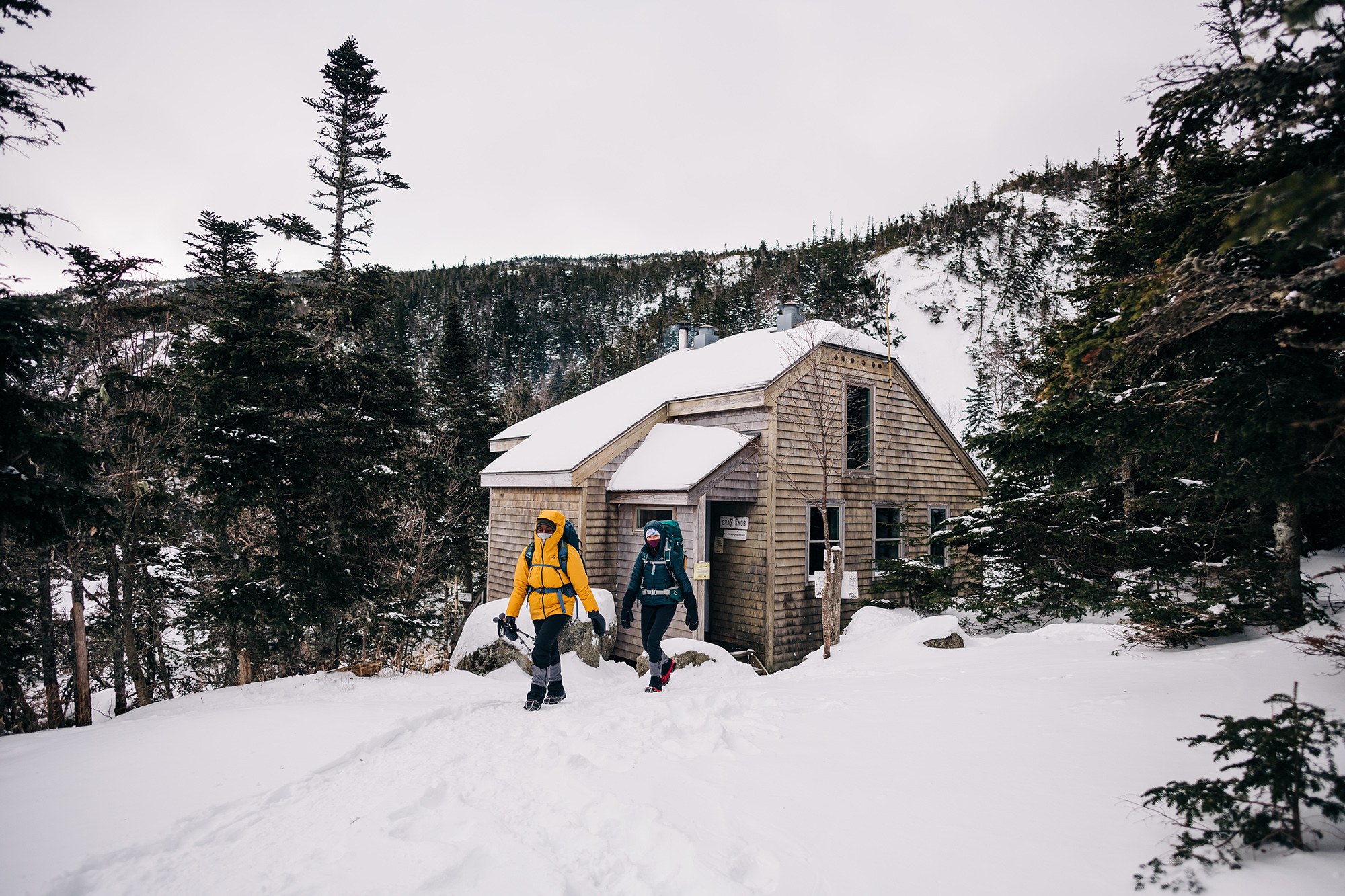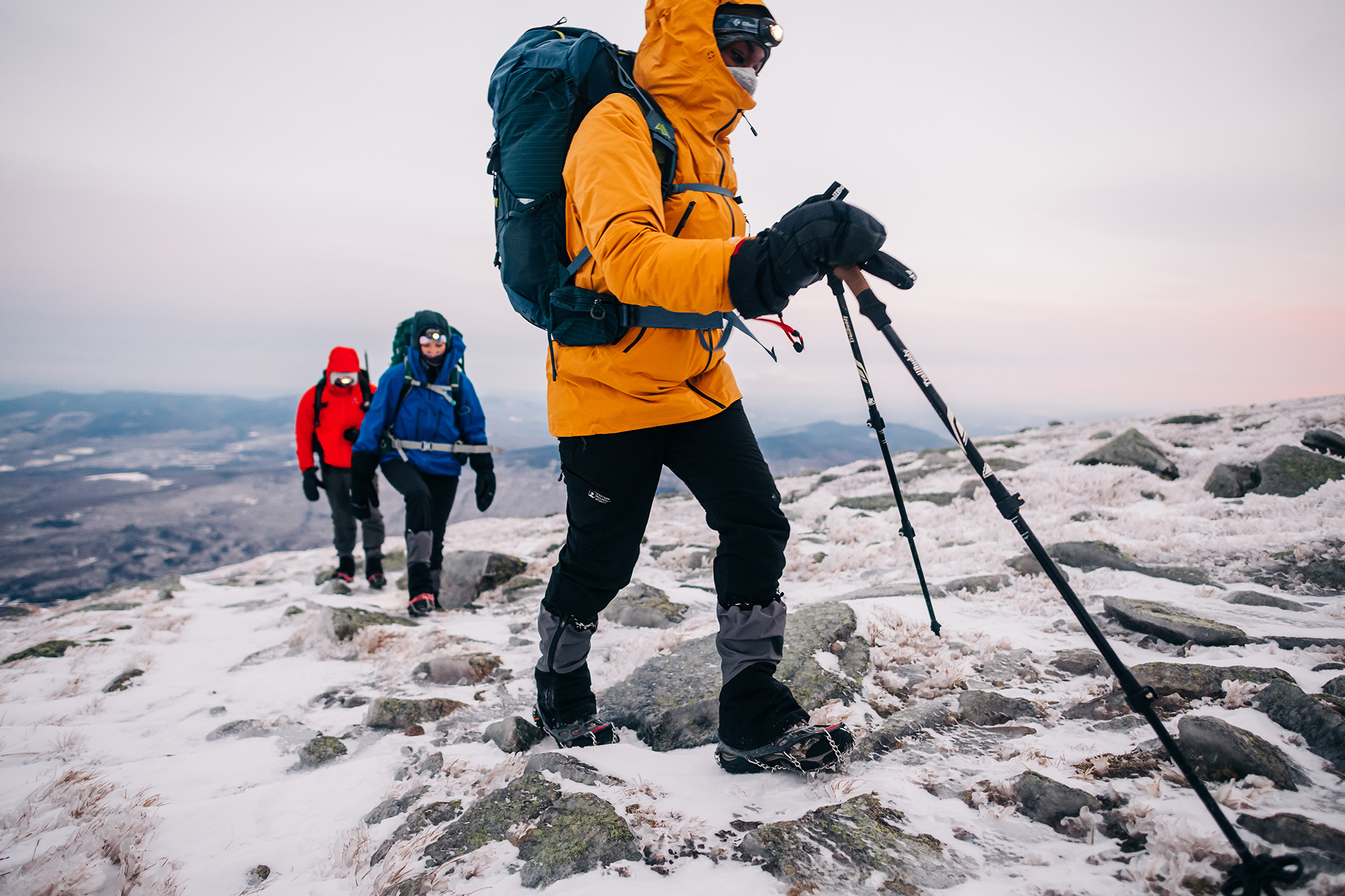7 Gear Essentials to Keep You Hiking All Winter Long

7 Gear Essentials to Keep You Hiking All Winter Long
Winter hiking can be as rewarding as summer hiking—if not more—but staying safe and comfortable in the cold means taking the right gear with you. / Photos by Corey McMullen
Every year, as the cool temperatures of autumn give way to the first winter snowfalls, many hikers begin planning for the end of the hiking season. Gear is packed away for the winter, not to be seen again until spring, and we mourn the end of our time climbing mountains, circumnavigating lakes and searching out waterfalls, creeks and many other of nature’s marvels.
But what if, as hikers, we could get excited about the coming of winter, rather than see it as a time to hibernate or turn our attention to other hobbies? The good news is that we can. Modern outdoor gear is making winter hiking safer and more comfortable than ever, and the basic gear needed to extend your hiking season through the winter months doesn’t have to be complicated or break the bank.
Here are some essentials that every winter hiker should consider taking with them into the backcountry.
1. Layers
 Adding warmer clothing layers as you transition from summer/fall to winter hiking may sound like a no-brainer, but there are two that become especially important during the winter months: a base layer and a shell.
Adding warmer clothing layers as you transition from summer/fall to winter hiking may sound like a no-brainer, but there are two that become especially important during the winter months: a base layer and a shell.
Generally made of wool or synthetic materials, a base layer is worn against the skin and, in addition to providing warmth, is essential for wicking moisture away so that it can evaporate quickly. Even in the coldest temperatures, it’s easy to work up a sweat while moving. And if the wind picks up, or you stop for a snack, that sweat can become a liability. A base layer will help move that moisture away from the body and keep you drier.
Worn on the outside of your layering system, a shell is your first line of defense against wind, snow or even rain. If conditions are cold and dry, a softshell will deflect wind and snow, while allowing moisture to escape. In contrast, a hard shell is more appropriate for wet or damp conditions. They are often made of materials like GORE-TEX or nylon, and while they offer better rain or wet snow protection than a softshell, they are often less breathable.
2. A Headlamp
 Hopefully, it never needs to be used, but shorter days in the winter make having a headlamp a safety essential. Darkness comes earlier in the winter—especially at higher and lower latitudes—increasing the chance that you might get caught out after sunset. And hiking in the dark is no fun. On a remote hike with no light, it can be difficult if not impossible to see either the ground or the sky.
Hopefully, it never needs to be used, but shorter days in the winter make having a headlamp a safety essential. Darkness comes earlier in the winter—especially at higher and lower latitudes—increasing the chance that you might get caught out after sunset. And hiking in the dark is no fun. On a remote hike with no light, it can be difficult if not impossible to see either the ground or the sky.
Other light sources such as a cell phone or a flashlight can help in a pinch, but a headlamp can be directed wherever it’s needed while leaving your hands free for other tasks. For the best cold weather performance and longest life, consider picking up a headlamp that uses built-in lithium batteries.
3. Sunglasses
 With the days getting shorter, it may sound counter-intuitive to suggest carrying sunglasses. But if there is snow on the ground, sunlight reflecting off of the white surface is amplified, and the intense UV rays can damage your eyes. In some cases, it can even cause snow blindness.
With the days getting shorter, it may sound counter-intuitive to suggest carrying sunglasses. But if there is snow on the ground, sunlight reflecting off of the white surface is amplified, and the intense UV rays can damage your eyes. In some cases, it can even cause snow blindness.
According to the American Academy of Ophthalmology (AAO), snow blindness is a form of photokeratitis that can be caused by UV rays reflecting off of ice and snow. It’s particularly common at the North and South Poles as well as in the high mountains where the thin air provides less protection from UV rays. Like a sunburn, UV damage to the eyes may not be apparent until well after it has occurred. Symptoms include pain, blurriness and swelling among others. To prevent eye damage the AAO recommends sunglasses or ski goggles that are designed to block or absorb 99 percent of UV rays.
4. Protection for Your Head, Hands and Feet
 Few things can make a winter hike more miserable than cold extremities. That’s because a large percentage of heat is lost through your head, hands and feet. So it’s important to keep them as protected from the elements as possible with a beanie, mitts or gloves and boots.
Few things can make a winter hike more miserable than cold extremities. That’s because a large percentage of heat is lost through your head, hands and feet. So it’s important to keep them as protected from the elements as possible with a beanie, mitts or gloves and boots.
A knit beanie or one made of fleece is your best bet for keeping your head and ears warm. Even if the forecast calls for warm temperatures, having this essential piece of winter gear with you can come in handy if you find yourself in unexpected conditions. A beanie is preferable to a headband because, while these will keep your ears warm, a headband also allows heat to escape through the top of your head.
Keeping your hands warm with gloves or mitts is important during a winter hike because once they get cold, it can be difficult to get them warm again. And cold fingers can become unusable for even the simplest tasks, like tying laces or pulling up the zipper on your jacket. If you’re able to pick up mitts or gloves that have wind and moisture-resistant outer shell and a removable insulating layer inside, you can easily switch from maximum protection to maximum dexterity.
And last but not least, we turn to boots. In some situations, using your warm-weather hiking boots on a winter hike will make sense. But in many cases, you’ll want to have something insulated and water-resistant—if not fully waterproof—on your feet. Even on cold, sunny days, snow can accumulate on boots and melt, seeping into your footwear and turning warm feet cold.
5. Traction/Snowshoes
 Winter hiking conditions can vary greatly. Even on the same hike, the terrain can change from bare ground to snow or ice in a very short distance, so it’s important to be prepared. Good quality footwear traction will allow you to cover icy ground easily and snowshoes will keep you moving efficiently over deep snow.
Winter hiking conditions can vary greatly. Even on the same hike, the terrain can change from bare ground to snow or ice in a very short distance, so it’s important to be prepared. Good quality footwear traction will allow you to cover icy ground easily and snowshoes will keep you moving efficiently over deep snow.
While it’s not likely practical to carry both traction and snowshoes, finding out what conditions are like through trail reports will help you decide on the right choice for any given day. In general, traction—like MICROspikes® and EXOspikes®—will be more useful in areas where winter conditions are relatively dry and icy, whereas snowshoes are your best bet where heavy snow and the time between snowfalls don’t allow trails to become packed.
6. Poles
 Slippery ice and snow can make even small slopes and uneven terrain difficult to navigate. But having what are almost a second set of feet—in the form of skiing or hiking poles—extend down from your hands can improve your stability and keep you upright and out of the snow.
Slippery ice and snow can make even small slopes and uneven terrain difficult to navigate. But having what are almost a second set of feet—in the form of skiing or hiking poles—extend down from your hands can improve your stability and keep you upright and out of the snow.
For winter hiking, ski poles work great. Or, if you happen to have summer hiking poles, they will work too. Summer poles often come with snow baskets that can be fitted to the bottom to provide more flotation in soft snow. If yours didn’t, check with the manufacturer to see if they’re available for purchase as an accessory.
7. Gaiters
 Waterproof boots will keep moisture from penetrating your footwear, but in snowy conditions, that may not be enough to keep your feet dry. This is where gaiters come in. Gaiters attach to your boot and extend up the calf, adding further protection from snow and cold wind.
Waterproof boots will keep moisture from penetrating your footwear, but in snowy conditions, that may not be enough to keep your feet dry. This is where gaiters come in. Gaiters attach to your boot and extend up the calf, adding further protection from snow and cold wind.
Many gaiters come in different heights, which provide different ranges of coverage. For winter conditions, we recommend a tall gaiter because snow conditions can change throughout the course of a hike and you don’t want to end up walking through deep snow with a short gaiter. For example, our NAVAgaiter™ GTX ultra-tough gaiter is available in tall and is made from GORE-TEX and nylon, which will seal out water and snow and can stand up to sharp rocks and repeated traction strikes.
Winter Rewards
 Winter can be one of the most rewarding times of year to hike, and with a little preparation combined with the right gear, a winter hike can also be a comfortable experience. The gear listed above is by no means an exhaustive list, but these basics will get you well on your way to a hiking season that never ends. For more tips on winter hiking, including safety considerations, check out our blog, “Embracing the Cold—Tips for a Safe and Rewarding Winter Hike.”
Winter can be one of the most rewarding times of year to hike, and with a little preparation combined with the right gear, a winter hike can also be a comfortable experience. The gear listed above is by no means an exhaustive list, but these basics will get you well on your way to a hiking season that never ends. For more tips on winter hiking, including safety considerations, check out our blog, “Embracing the Cold—Tips for a Safe and Rewarding Winter Hike.”
